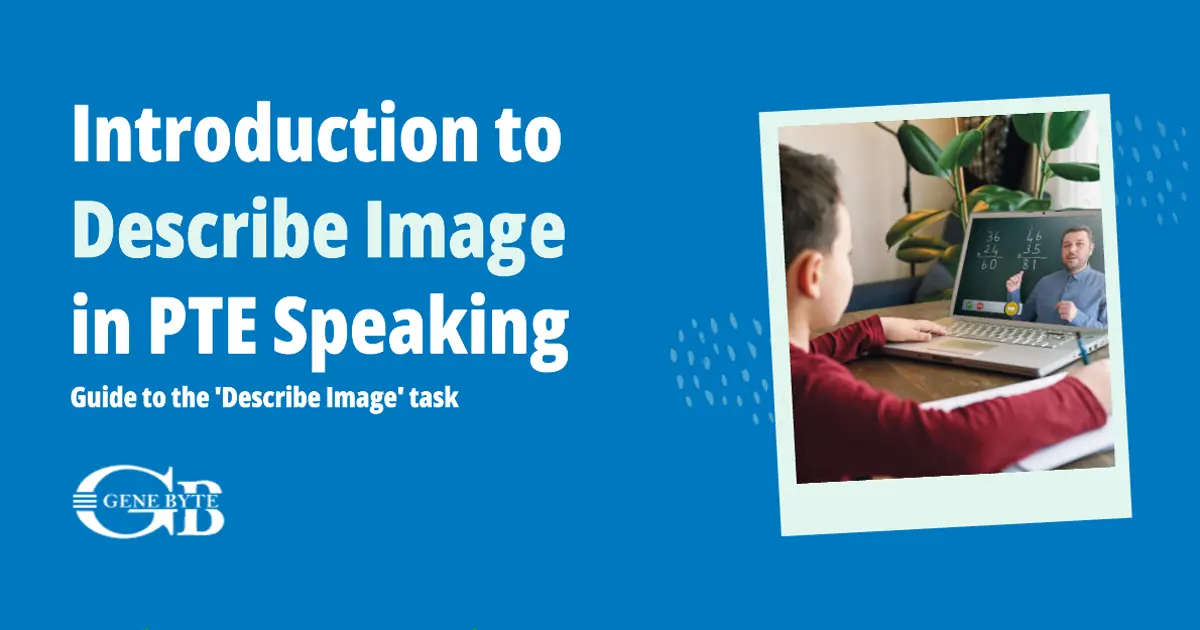Discussing PTE Describe Image:
An Essential Guide for Teachers
Unlocking the Describe Image Task in PTE Academic for Educators

"Mastering the Describe Image task in PTE Academic is not just about observing; it's about articulating a coherent and detailed response within a tight timeframe."
Is the Describe Image task from the Speaking Section of the PTE Academic a stumbling block for your students? As educators, effectively guiding students through this critical segment is essential. Genebyte offers innovative strategies and tools tailored for coaching institutes to conquer this challenge.
Key Takeaways:
- Task Importance: Crucial in the Speaking section, significantly influencing overall performance.
- Task Requirements: Students must interpret and articulate various images (graphs, charts, maps, process diagrams) within a tight timeframe.
- Effective Strategies: Educators need to understand task intricacies to guide students in clear and coherent image description and analysis.
- Innovative Solutions: Genebyte's AI-enhanced tools provide impactful teaching techniques to improve speaking skills and test performance.
- Empower Educators: Equip teachers with the necessary knowledge and tools to enhance teaching methods and elevate the learning experience.
By mastering the Describe Image task, educators can significantly boost their students' performance in the PTE Academic exam. Genebyte's resources support both teachers and students in achieving their goals.

Introduction to Describe Image in PTE Academic
Definition and Overview
In the Describe Image task that comes immediately after the Repeat Sentence task, the test-takers are presented with an image and required to deliver a detailed, coherent explanation within a set time frame. This task is not just about observing but involves a deep analysis and articulate description of various images, ranging from bar charts and line graphs to tables and pictures.
Importance in PTE Academic Speaking Test
This segment holds significant weight in assessing a candidate's speaking abilities, testing not only their observational skills but also their capacity to organize thoughts and express them clearly under timed conditions. Mastery in this task directly influences the overall speaking score, making it a crucial area for educators to focus on in their PTE preparation courses.

Understanding the Describe Image Task
Structure of the Task
-
Time Allocation for Preparation and Speaking
- Preparation Time: 25 seconds
- Speaking Time: 40 seconds
- Response Recording: Begins immediately after the preparation time
-
Types of Images Encountered
- Bar Graphs: Simplified visual data representation requiring concise yet comprehensive explanation.
- Line Graphs: Depict trends over time, demanding an analytical approach to describe changes.
- Pie Charts: Illustrate proportions and require precise interpretation of percentages.
- Tables: Present data in rows and columns, challenging the test-taker to summarize key information effectively.
- Process Diagrams and Maps: Visual representations requiring a detailed explanation of steps or locations.
Genebyte's Value Proposition
- Customized Training Modules: Genebyte's AI-driven platform offers tailored modules to train students on each image type, enhancing their ability to comprehend and articulate complex data.
- Real-time Feedback: With Genebyte's advanced analytics, educators can provide immediate and precise feedback on students' practice attempts, focusing on areas like fluency, pronunciation, and content accuracy.
- Practice Tools: Genebyte's solution includes a variety of practice tools that simulate the actual PTE test environment, allowing students to gain confidence and improve their performance in the Describe Image task.

Structure of the Describe Image Task
Skills Assessed
-
Speaking
- The Describe Image task primarily assesses the speaking skills of test-takers. It requires them to articulate their observations and analyses of the given image clearly and coherently. The challenge lies in conveying the essential elements of the image within the limited speaking time, demanding both clarity of thought and expression.
-
Oral Fluency and Pronunciation
- Oral fluency is crucial in this task, as it involves maintaining a natural, smooth flow of speech without undue hesitations or repetitions. Test-takers are evaluated on their ability to speak at a consistent and understandable pace.
- Pronunciation also plays a significant role. The ability to produce speech sounds that are clear and understandable to most regular speakers of the language is key. This includes the correct pronunciation of vowels, consonants, and appropriate stress on words and phrases.
-
Content Delivery
- The content of the response is scored based on how accurately and thoroughly the test-taker describes the image. This includes addressing all aspects and elements of the image, describing relationships, and drawing conclusions or implications based on the image's details.
Genebyte's Role in Enhancing Skill Development
- Genebyte's platform offers specialized modules focusing on each aspect of the Describe Image task, helping educators to target specific areas like fluency, pronunciation, and content delivery.
- The AI-driven analysis provides detailed insights into students' performance, enabling personalized feedback and improvement strategies.
- Interactive tools and real-life image examples on Genebyte's platform simulate the PTE Academic test environment, offering students ample practice opportunities to refine their skills.

Scoring Criteria for Describe Image
Content Evaluation
-
Accuracy and Completeness
- The content of the response is evaluated for its accuracy and completeness. Test-takers must address all elements of the image, including key features and relationships.
- The response should provide a comprehensive description, including any implications or conclusions that can be drawn from the image.
-
Description of Relationships and Implications
- A high-scoring response will not only describe the image but also intelligently discuss the relationships between different elements depicted.
- Test-takers should aim to articulate potential implications or conclusions based on the image's details, enhancing the depth of their description.
Oral Fluency Assessment
-
Speech Rhythm and Phrasing
- Oral fluency is judged on the rhythm and phrasing of the speech. A natural rate of speech with appropriate phrasing contributes to a higher score.
- Consistency in speaking pace and avoidance of hesitations or repetitions are key factors in this assessment.
-
Hesitations and Repetitions Impact
- Frequent hesitations, repetitions, or false starts can negatively affect the score. Test-takers should focus on delivering a smooth and uninterrupted flow of speech.
Pronunciation Considerations
-
Clarity and Understandability
- Pronunciation is assessed on the clarity and understandability of speech. Test-takers should produce speech sounds that are easily understandable to most regular speakers of the language.
- Accurate vowel and consonant sounds and correct word stress are crucial for achieving a high score in pronunciation.
-
Recognition of Regional and National Varieties
- PTE Academic recognizes various regional and national English pronunciation varieties to the extent that they are understandable to most regular speakers of the language.

Challenges in Teaching Describe Image
Common Difficulties Faced by Students
- Interpreting Complex Data: Students often struggle with understanding and explaining the more intricate aspects of images such as graphs and charts.
- Time Management: The challenge of concisely describing an image within the strict time limit of 40 seconds can be daunting for many.
- Language Barrier: Non-native English speakers may find it difficult to express their thoughts fluently and accurately.
Addressing Diverse Image Types
- Variety of Images: Instructors face the challenge of preparing students for a range of image types, each requiring a different approach.
- Ensuring Comprehensive Coverage: Educators must ensure students are equipped to handle any image type they encounter, from pie charts to process diagrams.
Balancing Content and Fluency
- Content Accuracy vs. Fluency: Teachers need to strike a balance between encouraging detailed content description and maintaining oral fluency.
- Pronunciation and Clarity: Teaching students to speak clearly and understandably, while also focusing on correct pronunciation, is critical.

Genebyte's Role in Enhancing Describe Image Preparation
Incorporating AI Tools in Teaching Methodologies
- Genebyte's AI tools are revolutionizing PTE Academic preparation by providing personalized learning experiences. These tools analyze students' performance in the Describe Image task, offering tailored recommendations and strategies for improvement.
- The AI-driven analytics help educators identify specific areas where students need more practice, such as understanding complex image types or improving time management skills.
Monitoring and Improving Oral Fluency and Pronunciation
- Oral fluency and pronunciation are critical components of the Describe Image task. Genebyte's advanced speech recognition technology provides immediate feedback on these aspects, helping students to refine their speaking skills.
- The platform offers interactive exercises that mimic real PTE Academic scenarios, allowing students to practice and improve their fluency and pronunciation in a controlled environment.
Emphasizing the Importance of Effective Teaching Strategies
- Genebyte empowers educators with a suite of tools and resources to develop more effective teaching strategies for the Describe Image task.
- The platform includes comprehensive training materials and real-life examples, enabling teachers to provide more in-depth and practical training to their students.
The Impact of Genebyte's Technology on PTE Academic Preparation
- Genebyte's technology streamlines the preparation process for the Describe Image task, making it more efficient and effective.
- By leveraging AI analytics, interactive learning modules, and real-time feedback mechanisms, Genebyte helps students to achieve higher scores in their PTE Academic tests.

Actionable Tips for Educators
- Focus on Key Elements: Teach students to identify main points in images, such as highest/lowest values in graphs, or given stages in a process.
- Fluency and Pronunciation: Leverage speech recognition technology for real-time, accurate feedback.
- Practice Time Management: Conduct timed sessions to help students get used to the 40-second speaking limit.
- Enhance Language Skills: Regularly work on relevant vocabulary and grammar to help non-native speakers as well.
- AI-Driven Learning: Use Genebyte's AI tools for in-depth practice, and personalized learning.
- Comprehensive Training Modules: Regularly work on relevant vocabulary and grammar to help non-native speakers as well.
The Describe Image task in PTE Academic can be challenging, but with the right strategies and tools, educators can prepare students for success. Genebyte's B2B SaaS solution offers comprehensive resources to enhance teaching methods and improve student outcomes. After this task the students can move to Retell Lecture, another task where they can use templates.
Get Started with Genebyte
Explore Genebyte's innovative solutions to revolutionize your PTE Academic preparation. Contact us to enhance your teaching and help your students excel in the Describe Image task.
Frequently Asked Questions
- Begin with a brief overview of the image.
- Mention key elements like highest and lowest points in graphs.
- Ensure your description follows a logical sequence.
- Conclude with any evident implications or conclusions.
- You're given an image (graph, table, map, etc.) to describe.
- Speak clearly and concisely, covering key aspects of the image.
- Aim for a balanced and comprehensive description.
- The exact number varies, but expect several describe image tasks.
- Each task requires different strategies based on the image type.
- Scoring is based on content, oral fluency, and pronunciation.
- Content score assesses how well you cover key elements and their relationships.
- Fluency and pronunciation are about the smoothness and clarity of speech.
This bar graph shows a comparison of sales figures over five years, with a noticeable peak in 2021 and a sharp decline in 2023.
- Practice various image types to familiarize yourself with different structures.
- Focus on speaking fluently without unnecessary pauses.
- Pay attention to pronunciation and clarity of speech.
- Understand the image quickly and identify its main point.
- Use specific vocabulary related to the image type.
- Stay organized in your description, with a clear start and finish.
- You have 25 seconds to prepare and 40 seconds to speak.
- Ensure to start speaking within 3 seconds when the microphone opens.
- Yes, templates can be used but should be adapted to fit the specific image.
- Fluency, pronunciation, and ability to convey relevant information about the image.
- Quickly glance at the image during the preparation time and form a mental outline.
- Start with a general statement about the image and then delve into specifics.
- Bar graphs, line graphs, pie charts, tables, process diagrams, maps, and more.
- Detail is important, but it should be balanced with brevity and relevance.
- No direct penalties, but unnecessary details can waste time and impact fluency.